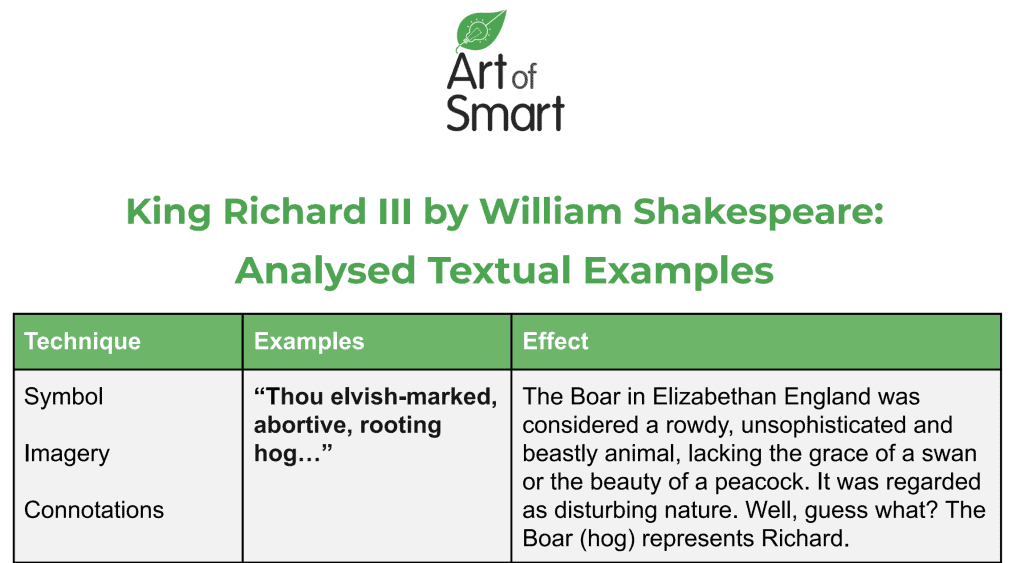Are you studying King Richard III and finding it difficult to craft a Band 6 analysis?
Well, we’re here to help! We’re going to walk you through the key characters, themes and a step-by-step guide of Shakespeare’s most murderous play to perfect your analysis.
PLUS we’ll provide you with a sample analysis table (also called a TEE table) and an example of a Band 6 paragraph for ‘‘King Richard III’! What more could you ask for?
Let’s get into it!
King Richard III by William Shakespeare Summary
Key Characters in King Richard III
Context
Themes Explored in King Richard III
Essay Analysis of King Richard III
King Richard III by William Shakespeare Summary
Richard of Gloucester of the House of York is a disfigured, hunchback young duke without love in his life. He is informed of his brother Edward’s ascension to the Throne of England after a victory in the civil war against the House of Lancaster.
Feeling excluded from court, Richard conjures up a plot to take the throne for himself.
Edward is misled by Richard, who prophesies that a family member with ‘G’ in their name would usurp the throne. Edward arrests his other brother, George.
George remains unaware of Richard’s plot, as Richard claims ignorance of the prophecy with him in prison.
Lady Anne, the widow of King Henry VI (the previous king of Engand, murdered by Richard himself), is persuaded by the hunchback to take him in marriage, despite Anne hating the guts out of the man! In a monologue to the audiences, Richard revels in his plan.
King Edward falls sick. The previously banished Queen Margaret (one of the wives of Henry VI) returns to court and curses every member of the new royals, including Richard, who is prophesied to ruin England.
Richard, as though to prove Queen Margaret right, arranges George’s murder. He captures all the relatives of King Edward, who passes away soon after the discovery of his illness.
Richard plots to kill them all, does just that, and is to be crowned King with the help of his sidekick, Lord Buckingham. He also imprisons King Edward’s sons, and plans to kill them too.
10+ heads are about to roll, and we’re only halfway through.
The announcement of his coronation is not popular. To incite more approval for his coronation, Richard stages an offering where Buckingham pleads with him to accept the crown — only after refusing it multiple times does he accept, seemingly out of insistence.
Buckingham, however, is reluctant to kill King Edward’s children. Richard turns on him, finding another assassin and forcing Buckingham to flee.
Eventually, Buckingham garners enough support to raise an army against Richard.
Richard, to secure his right to the throne, convinces Elizabeth (wife of King Edward), to let him marry his daughter as she mourns for her two dead boys (despite being executed on Richard’s orders)!
The Earl of Richmond (house of Lancaster) is also out to get Richard with an army, and while Buckingham’s forces scatter out of fear of Richard, and Buckingham is captured and killed, Richmond fares better.
Proving himself to be a worthy leader and honest man with his troops, Richmond defeats Richard and kills him, taking the crown. He marries Queen Elizabeth’s daughter, putting an end to the civil war.
Key Characters in King Richard III
Richard
Richard is a character born out of rejection, that has turned his unassuming disadvantages and superior intellect into dangerous weapons.
His physical characteristics, as well as his personality are fit for an antagonist-protagonist combination that chops off more heads than perhaps any English monarch.
The key thing about him is that everyone underestimates him as weak and unable to carry out the intricate and hard-to-pull-off, albeit cruel, murders he commits.
His ability for lying and misleading is matched by none. He carries the Boar as the symbol of the House of York.
Richmond
The hero of the play, the dramatic foil to Richard, and a constant ruler who treats his men well and gains the crown deservedly.
Richmond has very little in terms of interesting quirks, he is just the typical Shakespearean hero.
Edward
A blind king that does little to preserve himself or the welfare of his family, an undeserving ruler that Shakespeare chooses to finish off very quickly, as if telling audiences that the house of York breeds cruel and weak kings.
Buckingham
Buckingham’s loyalty and moral judgement right at the end of his life are perhaps what sets him apart from Richard the most.
While he does contribute to some of the murders, he recognises innocence in Edward’s children, hence why he refuses to kill them, and why he repents right before his death.
It would be a mistake to put him in the same category of cruelty that we would reserve for Richard, but we wouldn’t consider him a tragic hero.
Through Buckingham, we can see how ordinary men are susceptible to the possibility of power. Expecting to get rewarded, Richard shuns him instead, and Buckingham ends up receiving nothing but a hastened death in the end.
Elizabeth
A woman who grows increasingly powerless as Richard kills both her relatives and her sons.
It is unclear whether she agrees to give her daughter in marriage to Richard out of fear for herself and her daughter being the next victims on the chopping block, or because of a lack of judgement.
Ambiguity is interesting! Explore these character traits to your advantage depending on your exam question.
Context
The Wars of the Roses
Richard III is a dramatisation of the second half of the Wars of the Roses (1455–85).
Of course, Shakespeare has the daunting task to represent 14 years of bloody history in 5 Acts. He does this by taking huge shortcuts, as well as vilifying the real Richard III to a greater extent than he really was (although the representation is sadly pretty close).
The aforementioned cuts mainly skip over Edward’s reign.
The real Edward IV presided over an era of relative calm and prosperity, bringing some relief from the political and economic chaos of civil war.
The playwright that he is, Shakespeare compresses history and focuses on building intriguing plots and assassinations that make for good action. Playing between history and fiction, the play is a stark reminder to the anarchy England descended to during the Wars of the Roses.
Themes Explored in King Richard III
Power
The play isn’t just a struggle for power in a political sense, but also on a personal level. Let’s tackle these points separately.
Richard wants to hold the highest office in the Kingdom, and to achieve this, he is willing to go to lengths that most people will not go to. As he does, he tramples on the Elizabethan Era’s moral boundaries, including regicide, murder and dishonesty.
Naturally, you’d think that Richard just wants the political power, as there are almost no reflective scenes or soliloquies to explore the character. So, we must explore his characterisation and the dramatic foils that he interacts with!
However, Richard also craves personal power, or to put it simply, wants to empower himself, prove himself to others.
At the very beginning, we get the single rarest and profound glimpse into Richard, his deformed physicality that has led him to become both an outcast and a relative not worthy of respect among his peers.
This is precisely what Richard wants: respect. Unfortunately, due to his physical state, he is unable to get it out of love, and out of his bloodline, as he is preceded by his brother Edward.
To gain respect, he chooses fear instead. Remember this specific point, because on this hinges the play.
The Government and the State
The War of the Roses was a time of great suffering for the common people of Britain.
While lords dined and talked war, the men dying on the battlefield were poor farmers and citizens, who could find no other occupation other than the military.
This is because there was no state or government, nor the rule of law. Richard III is thus a warring against anarchy and the absence of authority and rule, that almost always leads organised societies into chaos.
How to Analyse ‘King Richard III’ in 3 Steps
Step 1: Choose your example
The best way to choose an example is to choose a technique.
Remember you must include stylistic devices (how images and words are arranged in a text in order to produce meaning), and aesthetic features (elements that prompt a critical response from the reader) in your essays to gain the most marks.
There are so many aspects to choose from this play that are interesting to analyse.
In this case, we’ll take Richard as our subject. Try to find examples that reveal his inner psychology, as those intimate moments are far and few between in a play that mainly features action after action.
Step 2: Identify your technique(s)
In this particular example, we’ll use the symbol of the Boar and Richard’s physical character traits to delve into his psychology.
Step 3: Write the analysis
Always be ready to ask yourself what the author intended you to feel/respond emotionally by reading the example quote. This will make sure that you tackle an important part of the analysis, which is the effect on the reader.
William Shakespeare brilliantly conveys the inner workings of his villain protagonist King Richard III, in his homonymous tragedy. He achieves this via the use of the House of York’s crest as a symbol for the villain, as well as Richard’s distinctive physical abnormalities and disabilities. Shakespeare thus transfers the ferocity, disruptiveness and cruel nature associated with boars onto Richard by drawing this metaphorical comparison. This is further amplified by the choice of characterisation that Shakespeare makes, exaggerating Richard III’s historical scoliosis into a severe hunchback, as well as giving him disfigurations.
Need some help with your essay analysis of other texts aside from King Richard III?
Check out other texts we’ve created guides for below:
- A Birthday Present
- All the Light We Cannot See
- Lord of the Flies
- Hamlet
- Jane Eyre
- The Book Thief
- Things Fall Apart
- Mrs Dalloway
- Hag-Seed
- Journey of the Magi
We’ve also got articles specifically on plays by Shakespeare which you can have a read through below:
- Macbeth
- Othello
- A Midsummer Night’s Dream
- Hamlet
- The Merchant of Venice
- Much Ado About Nothing
- Romeo and Juliet
- The Tempest
Are you looking for some extra help with studying King Richard III for English?
We have an incredible team of English tutors and mentors!
We can help you master your analysis of King Richard III by taking you through a summary, its key characters and themes. We’ll also help you ace your upcoming English assessments with personalised lessons conducted one-on-one in your home or online!
We’ve supported over 8,000 students over the last 11 years, and on average our students score mark improvements of over 20%!
To find out more and get started with an inspirational English tutor and mentor, get in touch today or give us a ring on 1300 267 888!
Vittorio Manessi is an Art of Smart tutor based in Queensland studying environmental science. He was one of the first Year 12 students to study under the new ATAR system in Queensland. He enjoys Maths, Science, English and Ancient History and is keen to share his knowledge of the QCE by making awesome resources.







